List of stumbling blocks in the Cologne district of Braunsfeld
The list of the stumbling blocks in the district of Cologne Braunsfeld results by artist Gunter Demnig laid stumbling blocks in the Cologne area Braunsfeld on.
The list of stumbling blocks is based on the data and research of the NS Documentation Center of the City of Cologne , partially supplemented by information and comments from Wikipedia articles and external sources. The aim of the art project is to document biographical details of the people who had their (last) voluntarily chosen residence in Cologne in order to preserve their memory.
- Note: In many cases, however, it is no longer possible to comprehend a complete description of their life and their path of suffering. In particular, the circumstances of her death can often no longer be researched. Official death notices from ghettos, detention centers, hospitals and concentration camps can often contain information that conceals the true circumstances of death, but are also documented taking this fact into account.
| image | Name and details of the inscription | address | Additional Information |
|---|---|---|---|

|
Here lived Arnold Altberger ( born in 1905)
|
Aachener Str. 443 ( location ) |
The stumbling block is reminiscent of Arnold Altberger , born in 1905.
The stumbling block for Arnold Alteberger was donated by students of the Georg Büchner Gymnasium (Cologne) . |

|
Here lived Amalie Banner ( born in 1923)
|
Aachener Str. 443 ( location ) |
The stumbling block is reminiscent of Amalie Malka Banner , born on February 25, 1923 in Cologne.
Amalie Banner, called “Malchen”, was born on Drachenfelsstrasse. After her mother's death in 1928, she grew up in the Abraham Frank House , a Jewish orphanage at Aachener Strasse 443. “Malchen”, who actually wanted to become a dancer, had a leg amputated by surgeons Alfred Roseno and Trude Löwenstein in 1934 due to a bone tumor disease in the Israelite asylum in Ehrenfeld . After her convalescence , the Israelite elementary school attended Lützowstrasse and began an apprenticeship as a tailor and milliner in 1938. Because the father Simon Banner had Polish citizenship, he and his daughters Selma and Amalie were forced to leave Germany on October 28, 1938 as part of the so-called " Poland Action ". Via the “makeshift warehouse” in Neu-Bentschen , “Malchen” was initially able to move to an aunt in Posen and train there to become a milliner . Shortly before the start of the Second World War , the Banner family moved to Warsaw , where they were isolated in the Warsaw ghetto after the occupation by German troops . Several letters from Malchen Banner have survived from this period. The last message from Amalie Banner comes from November 28, 1941. After that there is no more sign of life from her. It is believed that she and her family died of starvation in the ghetto. The stumbling block for Amalie Banner was donated by students from the Georg Büchner Gymnasium (Cologne) .
|

|
Here lived Selma Banner ( born in 1924)
|
Aachener Str. 443 ( location ) |
The stumbling block is reminiscent of Selma Banner , born on April 6, 1924 in Cologne.
After her mother's death in 1928, she grew up in the Abraham Frank House , a Jewish orphanage at Aachener Strasse 443. Because the father Simon Banner had Polish citizenship, he and his daughters Amalie and Selma were forced to leave Germany on October 28, 1938 as part of the so-called " Poland Action ". Selma Banner was deported to the Warsaw Ghetto in 1940 via the “makeshift camp ” in Neu-Bentschen , where she died in 1941. The stumbling block for Selma Banner was donated by students from the Georg Büchner Gymnasium (Cologne) .
|

|
Here lived Elise Barth ( born in 1874)
|
Wiethasestr. 37 ( location ) |
The stumbling block is reminiscent of Elise / Elisa Barth (née Meyer) , born on December 19, 1874 in Beurig .
Elise Barth was deported to the Auschwitz extermination camp in 1942 and murdered there. |
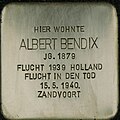
|
Here lived Albert Bendix ( born in 1879)
|
Hultzstrasse 24 ( location ) |
The Stolperstein, which was laid on September 26, 2019, commemorates Albert Bendix , born on August 12, 1879 in Dülmen .
Albert Bendix was director of the Barmer Bankverein Hinsberger, Fischer & Comp. as well as the business owner of the Barmer Bankverein Hinsberger, Fischer & Comp. KG a. A., Cologne and Lithuanian consul for Westphalia, the Rhine provenance and the Oldenburg region of Birkenfeld. The influential banker was a board member of several industrial companies. From 1933 until his expulsion to Holland in 1939, Bendix was chairman of the Jewish community in Cologne. On the day after the German occupation of the Netherlands, on May 15, 1940, Albert Bendix saw no way out and in Zandvoort all he could do was flee to death. The stumbling block for Albert Bendix, which was wrongly laid in front of the house at Hüllezstrasse 7, was renewed on September 26, 2019 and, together with the stumbling blocks for Bertha and Hans Josef Bendix and Henriette Stern, laid in front of the family home at Hältzstrasse 24. |
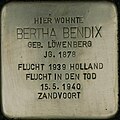
|
Here lived Bertha Bendix , born Löwenberg ( born 1878)
|
Hultzstrasse 24 ( location ) |
The Stolperstein laid on September 26, 2019 commemorates Bertha Bendix (née Löwenberg) , born on December 25, 1878 in Hörde .
She married the bank director Albert Bendix. The couple had a son (Hans Josef, born in 1909). In 1939 the family fled to the Netherlands. Together with Bertha's older sister Henriette Stern, they lived in Zandvoort at Brederodestraat 98. On the day after the German occupation of the Netherlands, on May 15, 1940, the Bendix family saw no way out and they could only flee to death. Bertha Bendix was buried in the Jewish cemetery in Haarlem. |

|
Here lived Hans Josef Bendix ( born in 1909)
|
Hultzstrasse 24 ( location ) |
The Stolperstein laid on September 26, 2019 commemorates Hans Josef Bendix , born on July 22, 1909 in Bonn.
|

|
Here lived Annie Benjamin , born Graumann ( born 1903)
|
Pauliplatz 13 ( location ) |
The stumbling block is reminiscent of Annie Benjamin (née Graumann) , born on August 23, 1903 in Cologne.
Annie Benjamin was initially able to emigrate to France , was later imprisoned in the Drancy assembly camp and deported to the Auschwitz death camp on August 14, 1942 . The stumbling block for Annie Benjamin was donated by students of the Georg Büchner Gymnasium (Cologne) . |

|
Here lived Siegfried Benjamin ( born in 1893)
|
Pauliplatz 13 ( location ) |
The stumbling block reminds of Siegfried Benjamin , born on January 7th, 1893 in Cologne.
Siegfried Benjamin was initially able to emigrate to France , was later imprisoned in the Drancy assembly camp and deported to Auschwitz on August 14, 1942 . The stumbling block for Siegfried Benjamin was donated by students of the Georg Büchner Gymnasium (Cologne) . |

|
Ernst Ludwig Eliel lived here ( born 1921)
|
Voigtelstrasse 22 ( location ) |
The Stolperstein, which was laid on September 25, 2019, commemorates Ernst Ludwig Eliel , who was born on December 28, 1921 in Cologne.
Ernst Ludwig Eliel was born in Cologne as the youngest son of Luise and Oskar Eliel. Due to his Jewish religious affiliation, Ernst Ludwig Eliel had to leave National Socialist Germany in 1938. He emigrated to Scotland and began studying chemistry. After the outbreak of war he was interned as an enemy alien and sent to Canada in 1940, where he continued his chemistry studies. A year later he went to Havana, where he studied at the University of Havana until 1946 . He then went to the United States , where he received his doctorate in organic chemistry in 1948. Eliel became a successful chemist and full professor at the University of Notre Dame and the University of North Carolina . He conducted research in the field of stereochemistry and in 1971 introduced the concept of topomerization . Ernest Eliel has received numerous awards and honors and was President of the American Chemical Society in 1992 . Ernest L. Eliel was married to Eva Schwarz and had two daughters. He died on September 18, 2008 in Chapel Hill . The stumbling block was donated by the German Alpine Association, Rhineland-Cologne section . |
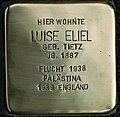
|
Here lived Luise Eliel , born Tietz ( born 1887)
|
Voigtelstrasse 22 ( location ) |
The Stolperstein, which was laid on September 25, 2019, commemorates Luise Eliel (née Tietz) , born on July 14, 1887 in Stralsund .
Luise Tietz was born in Stralsund as the third of five children of the Jewish businessman Leonhard Tietz and his wife Flora. Luise Tietz married the Cologne lawyer Oskar Eliel, with whom she had three sons Heinz Edgar (born 1908), Erwin Julius (born 1911) and Ernst Ludwig (born 1921). Luise Eliel was an active member of the Jewish women's association in Cologne. Luise Eliel had lived with her family at Voigtelstrasse 22 since 1935. After the increasing marginalization of Jewish citizens associated with the Nazis' seizure of power, the Eliel family was forced to flee to Palestine in October 1939 . They returned to Europe shortly afterwards; her husband died in Amsterdam in October 1939. Shortly after his death, she fled to Great Britain . In 1945 Luise Eliel went to Palestine again for two years. She returned to Great Britain in 1947 and moved to New York shortly before her death on March 2, 1948 . The stumbling block was donated by the German Alpine Association, Rhineland-Cologne section . |

|
This is where Dr. Oskar Eliel , ( born 1878)
|
Voigtelstrasse 22 ( location ) |
The Stolperstein, which was laid on September 25, 2019, commemorates Dr. Oskar Eliel , born on May 18, 1878 in Cologne.
Oskar Eliel was born as the eldest son of the merchant Louis Eliel and his wife Berta, b. Salomon born in Cologne. His father took over the short and fashionable goods store SJ Salomon from his father-in-law. Oskar Eliel had two brothers, Richard (born 1880) and Erich (born 1888). After completing his school education, he began to study law at the University of Cologne . He passed his legal traineeship exam in Cologne in 1899. He received his doctorate on December 3, 1901 in Heidelberg . On 10 August 1904 he was the Regional Court of Cologne as lawyer admitted; on March 16, 1908, he was admitted to the Higher Regional Court . Eliel was married to Luise Tietz, a daughter of Leonhard and Flora Tietz. The couple had three sons: Heinz Edgar (born 1908), Erwin Julius (born 1911) and Ernst Ludwig (born 1921). Oskar Eliel was legal advisor and chairman of the supervisory board of Leonard Tietz AG as well as a member of the supervisory board of the Cologne insurance company Patria . Oskar Eliel was a member of the Prussian State Association of Jewish Communities (PLV) and an active member of the Cologne synagogue community . After the National Socialists came to power , his license to practice as a lawyer was not revoked because he had already been a lawyer before 1914. However, his license was withdrawn on September 28, 1938. One month later, on October 31, 1938, he fled with his wife and sons, first to Palestine and then to the Netherlands . He died in Amsterdam on October 30, 1939 . In the Jewish cemetery in Cologne-Bocklemünd , an inscription on the family grave commemorates Oskar Eliel. The Stolperstein donated the German Alpine Association, Rhineland-Cologne section , of which Oskar Eliel had been a member since 1903. |
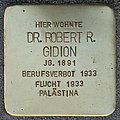
|
This is where Dr. Robert R. Gidion , ( born 1891)
|
Maarweg 27 ( location ) |
The Stolperstein, which was laid on April 18, 2018, reminds of Dr. Robert Rafael Gidion , born on May 6, 1891 in Cologne. |
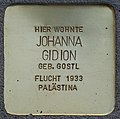
|
Here lived Johanna Gidion , born Gostl
|
Maarweg 27 ( location ) |
The Stolperstein, which was laid on April 18, 2018, is a reminder of Johanna Gidion , née Gostl.
The stumbling blocks for Robert R. Gidion and his family were donated by the Rhineland-Cologne section of the German Alpine Club . |

|
This is where Dr. Robert R. Gidion , ( born 1891)
|
Maarweg 27 ( location ) |
The Stolperstein, which was laid on April 18, 2018, reminds of Dr. Robert Rafael Gidion , born on May 6, 1891 in Cologne.
Robert Rafael Gidion was the son of a Jewish businessman and studied law at the University of Cologne . He passed his legal traineeship on June 18, 1912 and received his doctorate on September 22, 1912 in Heidelberg with a dissertation on the subject of "The execution of foreclosure in the so-called furniture leasing contract". For military service he was called up in 1913 as an unserved employee in the Landsturm . For military service he was drafted as a Landsturmmann in 1915 but released after 14 days. In November of the same year he was called up again for two months in the army. He passed the great state examination in December 1916 and was appointed as a court assessor for unpaid employment . As a result, he was called up again for military service and served until the end of the war . Robert Rafael Gidion was admitted to the bar on December 31, 1918 at the Cologne District and Regional Court . In 1923 he had to face a court of honor at the court of honor of the bar association “because he is supposed to have cigarettes against an inmate on remand ,” and he received a reprimand . On March 28, 1933, SA men removed Robert Rafael Gidion from a municipal stadium sports course on the grounds that “Jews are no longer allowed to enter and use the stadium facilities”. A letter of complaint from him to the mayor in this regard went unanswered. On May 5, 1933, Gidion was banned from being a representative and could no longer practice his profession. Robert Rafael then emigrated to Palestine . His license to practice as a lawyer was withdrawn on June 26, 1933 on the grounds "because he is not of Aryan descent". On March 31, 1937, Gidion from Tel Aviv asked the President of the Higher Regional Court to issue a certificate of his work as a trainee lawyer and attorney in Cologne in order to obtain his "admission to the Palestinian legal profession". This certificate was served on him and he was admitted to practice law in Palestine. Robert Rafael Gidion died in Israel in 1966 . The stumbling blocks for Robert R. Gidion and his family were donated by the Rhineland-Cologne section of the German Alpine Club . Robert Rafael Gidion had been a member of the Cologne Alpine Club since 1913, including the lender for the construction of the Cologne house above Serfaus in Tyrol . |
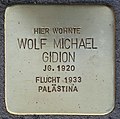
|
Wolf Michael Gidion lived here , ( born 1920)
|
Maarweg 27 ( location ) |
The Stolperstein, which was laid on April 18, 2018, commemorates Wolf Michael Gidion , born in 1920.
The stumbling blocks for Robert R. Gidion and his family were donated by the Rhineland-Cologne section of the German Alpine Club . |
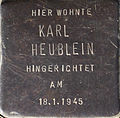
|
Here lived Karl Heublein ( year unknown)
|
Herzogenrather Str. 12 ( location ) |
The stumbling block is reminiscent of Karl Heublein .
Karl Heublein and his wife Martha belonged to a Franco-German group of friends and acquaintances who heard " enemy broadcasts ", made "critical remarks" in the air raid shelter and hid forced laborers who had fled . Targeted by the Gestapo , eight people from the group were arrested on November 5, 1944. During the arrest, some flyers were found that Martha Heublein had made calling for an end to the war. On January 16, 1945, the couple and Jean Pierre May were sentenced to death by the Cologne Senate of the People's Court . A command from the Cologne police force carried out the sentence on January 18, 1945 in Siegburg . |

|
Here lived Martha Heublein ( year unknown)
|
Herzogenrather Str. 12 ( location ) |
The stumbling block reminds us of Martha Heublein, who was born on February 18, 1898 in Mulhouse , Alsace .
Martha Heublein, born in Alsace and raised in France, was a French opera singer , translator and became an active resistance fighter in Cologne. Together with her husband Karl Heublein, she belonged to a Franco-German group of friends and acquaintances who heard “ enemy broadcasters ”, made “critical remarks” in the air raid shelter and hid forced laborers who had fled . Targeted by the Gestapo , eight people from the group were arrested on November 5, 1944. During the arrest, some litter cards were found that Martha Heublein had made, calling for an end to the war. On January 16, 1945, she, her husband Karl and Jean Pierre May were sentenced to death by the Cologne Senate of the People's Court . A command from the Cologne police force carried out the sentence on January 18, 1945 in Siegburg . In Cologne-Brück , Martha-Heublein-Strasse was named after her. |

|
Here lived Elisabeth Heymann , born Elias ( born 1879)
|
Voigtelstrasse 9 ( location ) |
The Stolperstein laid on March 19, 2019 commemorates Elisabeth Heymann (née Elias) , born in 1879.
Elisabeth Elias was married to the Cologne merchant Hermann Heymann, who was a partner in Betzinger & Partner and Apostellbau GmbH . Hermann Heymann died in 1931. After the handover of power to the National Socialists , Elisabeth Heymann initially stayed in Cologne and was able to protect herself from the repression of the National Socialists with the help of her Catholic domestic servants. In 1938 she emigrated to her brother in Brussels . She survived World War II in hiding and returned to Germany after the war, where she died in 1954. |
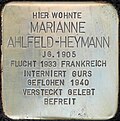
|
Here lived Marianne Ahlfeld-Heymann ( born in 1905)
|
Voigtelstrasse 9 ( location ) |
The Stolperstein, which was laid on March 19, 2019, commemorates Marianne Ahlfeld-Heymann , born on February 7, 1905 in Cologne.
Marianne Heymann grew up in a liberal family in Cologne. She received her school education at the Empress Augusta School ; Elsbeth Pollitz and Irmgard Keun were among her school friends . In 1922 she began training at the Cologne School of Applied Arts and in 1923 moved to the Bauhaus in Weimar . Here she attended the class for sculpture and theater. In 1925 Heymann returned to Cologne and made figures for a puppeteer. From 1926 to 1928 she did an internship at the Cologne Opera and then worked as an assistant at the Mannheim National Theater . From 1929 she designed costumes for numerous productions in Cologne and Mannheim . After the handover of power to the National Socialists , she emigrated to Paris via Ascona in April 1933 with the help of family members . In France she met the social democratic carpenter Hermann Ahlfeld (1892–1983). In 1937 she took part in the Paris World's Fair and received an award. Marianne Ahlfeld-Heymann was interned in Camp de Gurs for a few months in May 1940 . Released, the Ahlfelds survived the German occupation, hiding in southern France. In January 1949, the couple and their three children emigrated to Israel with the Aliyah , where they set up a carpentry shop in the Moshav Kfar Chaim, which ensured their survival. She died on June 26, 2003 in Haifa . |

|
Here lived Flora Kaiser Blüth , born Palm ( born 1880)
|
Raschdorffstr. 17 ( location ) |
The stumbling block is reminiscent of Flora Kaiser-Blüth (née Palm) , born on August 30, 1880 in Frankfurt am Main
Flora Kaiser Blüth was the wife of Julius Kaiser Blüth and was with her husband in the early 1940s in the " ghetto house " Rubensstr. 30 from the house at Raschdorffstraße 17 in Braunsfeld. On June 15, 1942, she was deported to the Theresienstadt ghetto on the first Cologne transport (III / 1, no. 177) . According to the death report issued in the Theresienstadt ghetto , she died on December 21, 1942 in building L 306. |
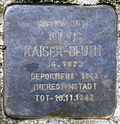
|
Here lived Julius Kaiser Blüth ( born in 1873)
|
Raschdorffstr. 17 ( location ) |
The stumbling stone is reminiscent of Julius Kaiser-Blüth , born on July 14, 1873 in Naumburg in Hesse .
Until the Aryanization in 1938, Julius Kaiser-Blüth was co-owner of the textile company Mannsbach & Lebach for work clothing , Lindenstrasse 19. Since the early 1940s, the Kaiser-Blüth couple were forcibly relocated to the “ ghetto house ” at 30 Rubensstrasse. While his sons Ernst Walter and Hans Wolfgang were able to emigrate, Julius Kaiser-Blüth was deported on June 15, 1942 with the first Cologne transport (III / 1 No. 176) to the Theresienstadt ghetto , where he died on November 10, 1942. The death report that was issued in the Theresienstadt ghetto states that the cause of death was “heart attack”. |

|
This is where Dr. Richard Katzenstein ( born 1868)
|
Raschdorffstr. 12 ( location ) |
The stumbling block that was laid in November 2002 commemorates Dr. Richard Katzenstein , born on October 21, 1868 in Eschwege .
After completing his school education in Giessen, Richard Katzenstein studied in Hanover and Würzburg, before enrolling in chemistry at the University of Rostock on October 24, 1890. The Katzenstein couple were forcibly relocated to the “ ghetto house ” at 18 Cäcilienstraße in the early 1940s . On June 15, 1942, he was deported to the Theresienstadt ghetto on the 1st Cologne Transport III / 1 . On December 7, 1942, according to the death report issued by the Theresienstadt ghetto , he died of “ pulmonary edema ” in the “Siechenheim” L 504 . The stumbling block for Richard Katzenstein was laid in November 2002 on the initiative of a school class at the Georg-Büchner-Gymnasium (Cologne) . The homeowner at Raschdorffstrasse 12 filed a lawsuit against the city of Cologne to have the stones removed and threatened to go to the constitutional court. Gunter Demnig reached an out-of-court settlement with the owner and in December 2003 moved the stones to a place closer to the street. |
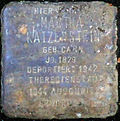
|
Martha Katzenstein , nee lived here . Cahn ( born 1879)
|
Raschdorffstr. 12 ( location ) |
The Stolperstein, which was laid in November 2002, commemorates Martha Katzenstein (née Cahn) , born on July 7, 1879 in Mainz .
Martha Katzenstein and her husband moved from the house in Braunsfeld to the “ ghetto house ” in Cecilienstrasse in the early 1940s . 18 forcibly relocated. On June 15, 1942, she was deported to the Theresienstadt ghetto on the 1st Cologne Transport III / 1 . On May 15, 1944, she was deported from Theresienstadt with Transport Dz (No. 734) to the Auschwitz extermination camp , where she was murdered. The stumbling block for Martha Katzenstein was laid in November 2002 on the initiative of a school class at the Georg Büchner Gymnasium (Cologne) . The homeowner at Raschdorffstrasse 12 filed a lawsuit against the city of Cologne to have the stones removed and threatened to go to the constitutional court. Gunter Demnig reached an out-of-court settlement with the owner and in December 2003 moved the stones to a place closer to the street. |

|
Here lived Ella coupling , born Simon ( born 1881)
|
Kitschburger Str. 229 ( location ) |
The stumbling block is reminiscent of Ella Koppel (née Simon) , born on June 20, 1881 in Rotterdam .
Ella Simon married Gisbert Koppel on July 12, 1905. The couple had two children. During the war, the Koppel family had to leave their apartment in Braunsfeld and were forcibly committed to the “ ghetto house ” at 18 Cäcilienstraße. On June 15, 1942, she and her husband were deported to the Theresienstadt ghetto on the first Cologne transport (III / 1) (“Siechenheim” Q 713). The official cause of death in the death report in the Theresienstadt ghetto stated that Ella Koppel suffered from old age and died on September 1, 1942 as a result of "heart failure". |

|
Here lived Gisbert Koppel ( born in 1876)
|
Kitschburger Str. 229 ( location ) |
The stumbling block is reminiscent of Gisbert Koppel , born on March 19, 1876 in Bochum .
During the war, the worker Gisbert Koppel and his wife Ella had to leave their apartment in Braunsfeld and were forcibly committed to the “ ghetto house ” at 18 Cäcilienstraße. On June 15, 1942, he was deported to the Theresienstadt ghetto with the first Cologne transport (III / 1), together with his wife Ella . On May 15, 1944, he was deported from there on the DZ transport to the Auschwitz extermination camp , where he was murdered. |

|
This is where Dr. Albert Kramer ( born 1887)
|
Pauliplatz 6 ( location ) |
The Stolperstein, which was laid on November 22, 2017, reminds of Dr. Albert Kramer , born on August 18, 1887 in Cologne.
Albert Kramer had worked in the Cologne city administration from 1914 and from 1920 to 1933 city director and finance director under Lord Mayor Konrad Adenauer . 1926/27 President of the Moriah Lodge of the B'nai B'rith order. On May 1, 1933, Dr. Albert Kramer dismissed from office because of his Jewish origin and retired. After his release he was active in the Jewish synagogue community, in Zionist associations and as a foreign exchange advisor for Jewish emigrants. He himself did not manage to emigrate . Dr. Albert Kramer and his wife Irma (born on July 4, 1897) were deported to the Litzmannstadt / Łódź ghetto on October 30, 1941 on the second Cologne deportation train ( II. Transport ) . Albert Kramer was entered in the transport list as the “transport guide” with the address at Lindenstrasse 19 (a former “ ghetto house ”) . Dr. Albert Kramer died on October 6, 1942 in the Litzmannstadt ghetto , the cause of death being noted as being "weak heart" . Another stumbling block for Albert Kramer was laid in front of his former school, the Kreuzgasse grammar school ( Vogelsanger Straße 1 ). |

|
Here lived Irma Kramer (born David) , ( born 1897)
|
Pauliplatz 6 ( location ) |
The Stolperstein, which was laid on November 22, 2017, commemorates Irma Kramer (née David) , born on July 4, 1897 in Cologne.
Irma Kramer was the daughter of Carl (Karl) and Paula David (née Scharfenberg) Irma Kramer and her husband Albert were deported to the Litzmannstadt / Łódź ghetto on October 30, 1941 on the second Cologne deportation train . In 1944 she was abducted from Litzmannstadt to the Auschwitz extermination camp , where she was murdered in August 1944. |

|
Here lived Jakob Fritz Marcan ( born in 1898)
|
Pauliplatz 11 ( location ) |
The Stolperstein, which was laid on October 22, 2015, commemorates Jakob Fritz Marcan |
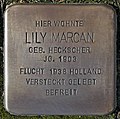
|
Here lived Lily Marcan , born Heckscher ( born 1903)
|
Pauliplatz 11 ( location ) |
The Stolperstein, which was laid on October 22, 2015, commemorates Lily Marcan (née Heckscher) , born October 16, 1903 in Hamburg .
Lily Heckscher was born as the second of four children to the owner of a lottery and banking business Julius Heckscher and his wife Marie (née Frank) in Hamburg. On April 14, 1926, she married the Cologne publisher Jakob Fritz Marcan. The sons Michael René (born 1930) and Klaus Martin (born 1931) resulted from the marriage. During the November pogroms in 1938 , her husband's house and business in downtown Cologne were devastated by members of the SA . Her husband began preparing for the family to emigrate back in 1937. On December 13, 1938 , the family emigrated to the Netherlands. In December 1940 the family moved to Naarden and was later able to rent a small house. When the deportations began in Naarden, the family went into hiding in Amsterdam , where the family survived in hiding. While the family settled in Naarden again in 1946, the older son Michael René emigrated to Israel . Lily Marcan died in Naarden in 1986. |

|
Here lived Jan. Pierre May ( year unknown)
|
Aachener Str. 450 ( location ) |
The stumbling block is reminiscent of Jean Pierre May .
The Jew Jean Pierre May belonged together with Karl and Martha Heublein to a Franco-German group of friends and acquaintances who heard “ enemy radio stations ”, made “critical remarks” in the air raid shelter and hid forced laborers who had fled . Targeted by the Gestapo , eight people from the group were arrested on November 5, 1944. During the arrest, some flyers were found that Martha Heublein had made calling for an end to the war. On January 16, 1945, the couple and Jean Pierre May were sentenced to death by the Cologne Senate of the People's Court . A command from the Cologne police force carried out the sentence on January 18, 1945 in Siegburg . |

|
Here lived Isidor Meier ( born 1881)
|
Wiethasestr. 37 ( location ) |
The stumbling block is reminiscent of Isidor Meier , born on September 9, 1881 in Pohl-Göns .
Isidor Meier emigrated to the Netherlands in 1937 and was later interned in the Westerbork transit camp. On May 4, 1943, he was deported to the Sobibor extermination camp and murdered there on May 7, 1943. |

|
Here lived Sophie Meier , born Meyer ( born 1890)
|
Wiethasestr. 37 ( location ) |
The stumbling block is reminiscent of Sophie Meier (née Meyer) , born on January 12, 1890 in Saarburg .
Sophie Meier emigrated to the Netherlands on April 20, 1939 and was later interned in the Westerbork transit camp. On May 4, 1943, she was deported to the Sobibor extermination camp and murdered there on May 7, 1943. |
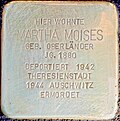
|
Here lived Martha Moises , born Oberländer ( born 1880)
|
Aachener Str. 412 ( location ) |
The Stolperstein, which was laid on March 19, 2019, commemorates Martha Moises (née Oberländer) , born on November 13, 1880 in Mannheim .
Martha Oberländer was the third of seven children of the Jewish merchant Joseph Oberländer and his wife Fanny, née. Aberle born in Mannheim. In September 1900 she married the Cologne merchant Sigmund Moises (different spelling: Moses) in Mannheim. The couple had a daughter, Gertrud, geb. on March 7, 1901 in Cologne. After the death of her husband, Martha Moses was forced to move into a ghetto house at "Horst-Wessel-Platz 14" (today Rathenauplatz). From there she was deported to the Theresienstadt ghetto on September 19, 1942 with Transport III / 5 . On May 15, 1944, Martha Moises was deported to the Auschwitz concentration camp on the DZ transport and murdered. Her daughter Gertrud, together with her husband, the doctor Max Ichenhäuser and their two daughters, emigrated via Great Britain to the United States in 1939 after Max Ichenhäuser was arrested during the November pogrom in 1938 and imprisoned in Brauweiler and Dachau concentration camp and later released. |

|
Here lived Sigmund Moises ( born in 1859)
|
Aachener Str. 412 ( location ) |
The Stolperstein laid on March 19, 2019 commemorates Sigmund Moises (Moses), born on September 25, 1859 in Stommeln .
On September 6, 1900, he married the daughter of the Jewish businessman Joseph Oberländer, Martha Oberländer, in Mannheim. Sigmund Moses ran a men's bespoke shop Oberländer & Cie in Glockengasse 18-20 in Cologne . At the beginning of the 1930s, Sigmund Moses retired from professional life for reasons of age. In 1932 the family moved from Kameckestrasse to the house in Aachener Strasse 412, which their son-in-law Max Ichenhäuser had acquired. After Max Ichenhäuser emigrated, the Moises (Moses) couple had to leave their house in Aachener Strasse 412. On March 25, 1942, Sigmund Moises died in the Jewish Hospital in Ehrenfeld, Ottostraße 85. He was buried in the Jewish cemetery in Cologne-Bocklemünd . |

|
Here lived Hedwig Rosenbaum ( born in 1873)
|
Maarweg 54 ( location ) |
The stumbling stone is reminiscent of Hedwig Rosenbaum (née Guthmann) , born on March 20 or April 1873 in Letmathe .
During the war Hedwig Rosenbaum lived in Bonn and most recently in Cologne. On June 15, 1942, she and her husband Issak were deported on the first Cologne transport (III / 1) to the Theresienstadt ghetto , where she officially died of " gastroenteritis " on September 27, 1942 in the Siechenblock GV, Berggasse 13 . |

|
Here lived Isaac Rosenbaum ( born in 1875)
|
Maarweg 54 ( location ) |
The stumbling stone is reminiscent of Isaak Rosenbaum , born on April 28, 1875 in Leuven .
The merchant Isaak Rosenbaum was deported to the Theresienstadt ghetto on June 15, 1942, together with his wife Hedwig on the first Cologne transport (III / 1) , where he was murdered on June 3, 1943. |

|
Here lived Alfred Rosenberg ( born in 1912)
|
Burtscheider Str. 19 ( location ) |
The Stolperstein laid on November 22, 2017 commemorates Alfred Rosenberg , born in 1912. |

|
Here lived Alice Rosenberg , born Marum ( born 1887)
|
Burtscheider Str. 19 ( location ) |
The Stolperstein, which was laid on November 22, 2017, commemorates Alice Rosenberg (née Marum) , born on September 8, 1887 in Karlsruhe . |

|
Here lived Karl Heinz Rosenberg ( born in 1921)
|
Burtscheider Str. 19 ( location ) |
The Stolperstein, which was laid on November 22, 2017, commemorates Karl Heinz Rosenberg , born in 1921. |

|
Here lived Margot Rosenberg ( born in 1913)
|
Burtscheider Str. 19 ( location ) |
The Stolperstein laid on November 22, 2017 commemorates Margot Rosenberg , born in 1913. |

|
Here lived August Samuel Dorff ( born in 1885)
|
Wiethasestr. 20 ( location ) |
The stumbling block is reminiscent of August Samuelsdorff , born on September 29, 1885 in Borgholz .
August Samuelsdorff was deported on June 15, 1942 with his wife Martha from the last known registration address of the “ Ghettohaus ” in St. Apernstrasse 29–31 with the first Cologne transport (III / 1) to the Theresienstadt ghetto . From there he was transferred to the Auschwitz extermination camp on October 6, 1944 . In 1945 he was pronounced dead. The stumbling block for August Samuelsdorff was donated by students from the Georg Büchner Gymnasium (Cologne) . |

|
Martha Samuelsdorff , nee lived here . Wolf ( born 1891)
|
Wiethasestr. 20 ( location ) |
The stumbling block is reminiscent of Martha Samuelsdorff (née Wolf) , born on December 19, 1891 in Bernkastel .
Martha Samuelsdorff was deported on June 15, 1942 with her husband August from the last known registration address of the “ Ghettohaus ” in St. Apernstrasse 29–31 with the first Cologne transport (III / 1) to the Theresienstadt ghetto . From there she was transferred to the Auschwitz extermination camp on October 6, 1944 . In 1945 she was pronounced dead. Stumbling block for Martha Samuelsdorff was donated by students of the Georg-Büchner-Gymnasium (Cologne) . |

|
Here lived Pink Silk , born Altberger ( born 1911)
|
Aachener Str. 443 ( location ) |
The stumbling block is reminiscent of Rosa Seiden (née Altberger) , born on February 12, 1911 in Frankfurt am Main .
The housewife Rosa Seiden was married to Markus Seiden and was initially able to emigrate to Belgium , was later imprisoned in the SS assembly camp in Mechelen and from there on April 19, 1943, deported to the Auschwitz extermination camp . In 1945 she was pronounced dead. The stumbling block for Rosa Seiden was donated by students from the Georg-Büchner-Gymnasium (Cologne) . |

|
Henriette Stern , nee lived here . Löwenberg ( born 1873)
|
Hultzstrasse 24 ( location ) |
The Stolperstein laid on September 26, 2019 commemorates Henriette Stern (née Löwenberg) , born on February 8, 1873 in Hörde-
Henriette Löwenberg was married to the Jewish textile merchant Bernhard Bonefang Stern, who died on April 20, 1937 in Herzebrock near Rheda-Wiedenbrück . The couple had two children: Julius (born 1902) and Frieda (born 1908). In 1939 Henriette Stern fled to the Netherlands with her sister's family. Here they lived at 98 Brederostraat in Zandvoort . One day after the German Wehrmacht occupied the Netherlands , the Jewish family saw no way out and fled to their deaths together. Henriette Stern was buried in the Jewish cemetery in Haarlem. Henriette's children managed to escape to Great Britain and the United States. |

|
Here lived Therese Wallach ( born in 1895)
|
Aachener Str. 443 ( location ) |
The stumbling stone is reminiscent of Therese Wallach , born on May 8, 1895 in Linz am Rhein .
Therese Wallach was a teacher. After training as a kindergarten teacher in Ahlem near Hanover, in 1924 she took over the management of a Jewish orphanage, the Abraham-Frank-Haus in Aachener Straße 443. In 1941 the orphanage was closed and the children with the children of the Jewish children's home from Lützowstraße in the Jewish community center merged in the Cäcilienstraße. Therese Wallach looked after the girls and the director of the children's home, Moritz Rülf the boys. On July 20, 1942, the children of the orphanage were deported to Minsk on the DA 219 special train from Cologne-Deutz and shot on July 24, 1942 immediately upon arrival. Therese Wallach committed suicide on October 18, 1942 before she was deported to the internment camp Fort V Müngersdorf . The stumbling block for Therese Wallach was donated by students of the Georg Büchner Gymnasium (Cologne) . Her grave is in the Jewish cemetery in Cologne-Deckstein . |
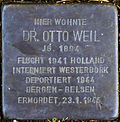
|
This is where Dr. Otto Weil ( born 1894)
|
Wiethasestr. 37 ( location ) |
The stumbling block reminds of Dr. Otto Weil was born on July 15, 1894 in Kirn (Kreuznach district).
Otto Weil was a Jewish lawyer. During the First World War , Otto Weil volunteered and was promoted to vice sergeant and aspiring officer and was awarded the Iron Cross, 2nd class . After his discharge from military service on November 18, 1918, Weil began studying law. He passed the legal traineeship exam on April 14, 1919 in Cologne. He passed the Grand State Examination on April 3, 1922 and received his doctorate on November 16, 1923. After being appointed court assessor, Weil immediately took a leave of absence to take up employment in a metal wholesaler. The leave of absence was extended until his appointment as a lawyer on July 1, 1926. His office was in Elisenstrasse 17, the seat of the Lissauer company . Otto Weil went to Amsterdam in 1938 as legal advisor to the Lissauer company and on September 26, 1938, the Reich Ministry of Justice withdrew his license to practice as a lawyer “because he has given up his place of residence and his office in Cologne”. His last known residence in Cologne was at Wiethasestrasse 37. Otto Weil was imprisoned in the Westerbork transit camp in the Netherlands and deported from there on July 31, 1944 to the Bergen-Belsen concentration camp. Otto Weil was murdered there on January 23, 1945. |
source
Individual evidence
- ↑ a b c d e f g h i j k gbg-koeln.de -> Installation: Stolpersteine -> our stones ( Memento of the original from March 4, 2016 in the Internet Archive ) Info: The archive link was automatically inserted and still Not checked. Please check the original and archive link according to the instructions and then remove this notice. , accessed March 1, 2016
- ↑ bundesarchiv.de: Memorial book entry Banner, Amalie Malka
- ↑ Horst Matzerath , Elfi Pracht , Barbara Becker-Jákli (eds.): Jüdisches Schicksal in Köln 1918–1945 - Catalog for the exhibition of the Historical Archives of the City of Kön / NS Documentation Center (November 8, 1988 to January 22, 1989, in Cologne Stadtmuseum / Alte Wache), City of Cologne 1988, page 307
- ↑ NS-Doc: Biography Banner, Amalie
- ↑ Dieter Corbach: Cologne and Warsaw are two worlds: Amalie Banner - suffering from Nazi terror . 1st edition. Scriba-Verlag, Cologne 1993, ISBN 978-3-921232-43-9 , p. 104 .
- ↑ Kirsten Serup-Bilfeldt: Between Cathedral and Star of David. Jewish life in Cologne from the beginning until today . Ed .: Ulrike Mast-Kirschning. KiWi, Cologne 2001, ISBN 3-462-03508-8 , p. 185-191 .
- ↑ bundesarchiv.de: memorial book entry Banner, Selma
- ↑ bundesarchiv.de: memorial book entry for Barth, Elise Elisa
- ↑ bundesarchiv.de: Biographical entry for Albert Bendix
- ^ Coesfeld local family register
- ^ Bundesarchiv.de: memorial book entry for Bendix, Albert
- ^ Commemorative sheet Bertha Bendix-Löwenberg. www.joodsmonument.nl, accessed on November 12, 2019 (Dutch).
- ↑ Bertha Bendix memorial sheet. In: Memorial Book Federal Archives. Retrieved November 12, 2019 .
- ↑ a b c Lucas Luchtenberg: Mij krijgen ze niet levend: de zelfmoorden van mei 1940 . Uitgeverij Balans, Amsterdam 2017, ISBN 978-94-6003-955-3 .
- ^ Commemorative sheet of Hans Josef Bendix. joodsmonument. nl, accessed on November 12, 2019 .
- ↑ NS Documentation Center Cologne: entry in the memorial book of Hans Josef Bendix. Retrieved November 12, 2019 .
- ^ Bundesarchiv.de: Entry in the memorial book for Benjamin, Annie
- ^ Bundesarchiv.de: entry in the memorial book for Benjamin, Siegfried
- ↑ UNC Chemistry: Obituary Ernest L. Eliel. August 27, 2014, accessed November 11, 2019 .
- ↑ Jeffrey I. Seema: Ernest L. Eliel: A Life of Purpose, Determination, and Integrity. Chirality, 2002, accessed November 12, 2019 .
- ↑ a b c Topic anti-Semitism. Rhineland-Cologne section of the DAV, accessed on November 11, 2019 .
- ^ A b Klaus Luig: --because he is not of Aryan descent: Jewish lawyers in Cologne during the Nazi era . O. Schmidt, Cologne 2004, ISBN 3-504-01012-6 , pp. 169 f .
- ^ A b Barbara Becker-Jákli: The Jewish cemetery in Cologne-Bocklemünd: history, architecture and biographies . emons, Cologne, ISBN 978-3-95451-889-0 , p. 78-80 .
- ↑ Werner Röder, Herbert A. Strauss: Biographical Handbook of German-Speaking Emigration after 1933-1945: Volume 1: Politics, Economy, Public Life . De Gruyter, Berlin 1980, ISBN 978-3-11-186584-3 , p. 762 .
- ^ André Postert: "Whoever wants to become a member must be of Aryan descent." Anti-Semitism in the Rhineland-Cologne section of the Alpine Association . Ed .: Rhineland-Cologne section of the Alpine Club. Cologne 2016, p. 21st f .
- ↑ Max P. Birnbaum: State and Synagogue, 1918-1938: a history of the Prussian State Association of Jewish Communities (1918-1938) . Mohr, Tübingen 1981, ISBN 3-16-743772-3 , p. 95 .
- ↑ a b c dav-koeln.de: Topic anti-Semitism , accessed on April 22, 2018
- ↑ Klaus Luig : ... because he is not of Aryan descent: Jewish lawyers in Cologne during the Nazi era . 1st edition. Otto Schmidt, Cologne 2004, ISBN 3-504-01012-6 , p. 191-192 .
- ↑ dav-koeln.de: "Whoever wants to become a member must be of Aryan descent." Anti-Semitism in the Rhineland-Cologne section of the Alpine Association (pdf), accessed on April 22, 2018
- ^ A b c Carl Dietmar and Werner Jung : Cologne. The great city history . 1st edition. Klartext, Essen 2015, ISBN 978-3-8375-1487-2 , p. 431 .
- ↑ a b c Ulrich Soénius and Jürgen Wilhelm (eds.): Kölner Personen Lexikon . 1st edition. Greven, Cologne 2008, ISBN 978-3-7743-0400-0 , pp. 240 .
- ↑ a b c Commemoration of the Victims of National Socialism , accessed on February 10, 2017
- ↑ a b Erhard R. Wiehn; Marianne Ahlfeld-Heymann: And still survived: a Jewish fate from Cologne through France to Israel, 1905–1955: with memories of Paul Klee . Hartung-Gorre, Konstanz 1994, ISBN 3-89191-730-9 .
- ↑ Die Zeit: When decency was still a matter of course . In: The time . December 27, 1985, ISSN 0044-2070 ( zeit.de [accessed March 27, 2019]).
- ↑ Julia Franke: Paris, a new home? Jewish emigrants from Germany 1933–1939. Duncker & Humblot, Berlin 2000, p. 378-414 .
- ↑ Transport list of the deportation train to Theresienstadt, June 15, 1942, (III / 1), page 9, no. 177
- ↑ Obituary report Ghetto Theresienstadt: Flora Kaiser - Blüth ( Memento of the original from April 2, 2015 in the Internet Archive ) Info: The archive link was inserted automatically and has not yet been checked. Please check the original and archive link according to the instructions and then remove this notice.
- ↑ bundesarchiv.de: Memorial Book entry for Kaiser Blüth, Flora
- ↑ NS-Doc annual report 2012, p. 97
- ↑ Transport list of the deportation train to Theresienstadt, June 15, 1942, (III / 1), page 9, no.176
- ↑ Julius Kaiser-Blüth's death report ( page no longer available , search in web archives ) Info: The link was automatically marked as defective. Please check the link according to the instructions and then remove this notice.
- ↑ bundesarchiv.de: Memorial Book entry for Kaiser Blüth, Julius
- ^ University of Rostock, registration of Richard Katzenstein
- ^ Deportation list Transport III / 1 from Cologne to Theresienstadt on June 15, 1942; Sheet 10, entry 191
- ^ Deportation train Transport III / 1 from Cologne to Theresienstadt on June 15, 1942
- ↑ holocaust.cz Richard Katzenstein ( Memento of the original from March 1, 2015 in the Internet Archive ) Info: The archive link was inserted automatically and has not yet been checked. Please check the original and archive link according to the instructions and then remove this notice.
- ^ Bundesarchiv.de: entry in the memorial book for Katzenstein, Richard
- ^ Nazi doc: memorial book entry for Dr. Richard Katzenstein
- ^ A b Max-Leo Schwering: Cologne Braunsfeld - Melaten . 1st edition. Publication of the Cologne City Museum Volume 6, Cologne 2004, ISBN 3-927396-93-1 , p. 322 .
- ^ Deportation list Transport III / 1 from Cologne to Theresienstadt on June 15, 1942; Sheet 10, entry 192
- ^ Deportation train Transport III / 1 from Cologne to Theresienstadt on June 15, 1942
- ↑ holocaust, cz: Martha Katzenstein ( Memento of the original from March 1, 2015 in the Internet Archive ) Info: The archive link was inserted automatically and has not yet been checked. Please check the original and archive link according to the instructions and then remove this notice.
- ↑ bundesarchiv.de: memorial book entry for Katzenstein, Martha
- ^ Transport list of the deportation train to Theresienstadt, June 15, 1942, (III / 1), page 9, no.162
- ↑ holocaust.cz Ella Koppel death report ( memento of the original from February 26, 2015 in the Internet Archive ) Info: The archive link was inserted automatically and has not yet been checked. Please check the original and archive link according to the instructions and then remove this notice.
- ↑ bundesarchiv.de: memorial book entry for Koppel, Ella
- ^ Transport list of the deportation train to Theresienstadt, June 15, 1942, (III / 1), page 9, no.162
- ↑ holocaust.cz: Gisbert Koppel ( memento of the original from March 4, 2016 in the Internet Archive ) Info: The archive link was inserted automatically and has not yet been checked. Please check the original and archive link according to the instructions and then remove this notice.
- ↑ Yad Vashem database: Gisbert Koppel memorial sheet
- ↑ bundesarchiv.de: memorial book entry for Koppel, Gisbert
- ^ Bundesarchiv.de: memorial book entry for Kramer, Albert
- ↑ Dieter Corbach, Mazal Holocaust Collection: 6.00 a.m. from the Cologne-Deutz exhibition center - deportations 1938–1945: = Departure: 6.00 a.m. at the Cologne-Deutz exhibition center - deportations 1938–1945 . Scriba-Verl, Cologne 1999, ISBN 3-921232-46-5 , p. 383 .
- ↑ Cologne-Litzmannstadt deportation list on October 30, 1941, sheet 11, entry no.508
- ^ Deportation train 16. Transport from Cologne to Litzmannstadt on October 30, 1941
- ↑ Klaus Luig : ... because he is not of Aryan descent: Jewish lawyers in Cologne during the Nazi era . 1st edition. Otto Schmidt, Cologne 2004, ISBN 3-504-01012-6 , p. 248 .
- ^ Bundesarchiv.de: memorial book entry for Kramer, Irma
- ↑ Yad Vashem: Memorial sheet for Irma Kremer
- ↑ Yad Vashem: Memorial sheet for Irma Kremer
- ↑ Cologne-Litzmannstadt deportation list on October 30, 1941, sheet 11, entry no.509
- ^ Deportation train 16. Transport from Cologne to Litzmannstadt on October 30, 1941
- ↑ stadt-koeln.de of April 26, 2016: Stumbling block for former city director , accessed on December 10, 2017
- ↑ NS Documentation Center Cologne - | Lily Marcan. Retrieved October 20, 2018 .
- ↑ Jutta Riedel-Henck: Else Thalheimer (part 2). Retrieved October 20, 2018 .
- ↑ Jutta Riedel-Henck: Else Thalheimer (part 3). Retrieved October 20, 2018 .
- ↑ bundesarchiv.de: memorial book entry for Meier, Isidor
- ↑ bundesarchiv.de: memorial book entry for Meier, Sophie
- ↑ Martha Moses | Victims database Ghetto Theresienstadt. Retrieved March 27, 2019 .
- ↑ Memorial sheet for Martha Moses. Yad Vashem, accessed March 27, 2019 .
- ↑ Entry in the memorial book for Martha Moses. Federal Archives, accessed on March 27, 2019 .
- ↑ detainees with the first letter I. LVR-Kulturzentrum Brauweiler Abbey, accessed on March 27, 2019 .
- ↑ Stumbling stone laying by Sigmund Moises. Irmgardis Gymnasium Cologne, accessed on March 27, 2019 .
- ↑ Death register entry No. 347, Standesamt Köln-Ehrenfeld, 1942, Volume 1. Historical Archive Cologne, accessed on March 27, 2019 .
- ↑ Transport list of the deportation train to Theresienstadt, June 15, 1942, (III / 1), page 4, no.71
- ↑ Hedwig Rosenbaum's death report from the Theresienstadt ghetto ( Memento of the original from February 26, 2015 in the Internet Archive ) Info: The archive link was inserted automatically and has not yet been checked. Please check the original and archive link according to the instructions and then remove this notice.
- ↑ bundesarchiv.de: memorial book entry for Rosenbaum, Hedwig
- ↑ Transport list of the deportation train to Theresienstadt, June 15, 1942, (III / 1), page 4, no.71
- ^ Yad Vashem database: Isaak Rosenbaum memorial sheet
- ↑ bundesarchiv.de: memorial book entry for Rosenbaum, Isaak
- ^ Bundesarchiv.de: memorial book entry for Rosenberg, Alice
- ^ Transport list for the deportation train to Theresienstadt, June 15, 1942, (III / 1), page 34, no. 665
- ↑ bundesarchiv.de: Memorial Book entry for Samuel Dorff, August
- ^ Transport list of the deportation train to Theresienstadt, June 15, 1942, (III / 1), page 34, no. 666
- ↑ bundesarchiv.de: Memorial Book entry for Samuel Dorff, Martha
- ↑ bundesarchiv.de: Memorial book entry for Seiden, Rosa
- ^ Yad Vashem: Commemorative Sheet for Pink Seiden , accessed on February 8, 2017
- ↑ Henriette Stern's memorial sheet. In: Federal Archives Memorial Book. Retrieved November 12, 2019 .
- ↑ Henriette Stern's memorial sheet. NS Documentation Center Cologne, accessed on November 12, 2019 .
- ↑ Henriette Stern's memorial sheet. In: joodsmonument.nl. Retrieved November 12, 2019 .
- ^ Bundesarchiv.de: Wallach, Therese memorial book entry
- ↑ statistik-des-holocaust.de: Deportation from Cologne to Minsk on July 20, 1942
- ^ Ulrich Soénius and Jürgen Wilhelm (eds.): Kölner Personen Lexikon . 1st edition. Greven, Cologne 2008, ISBN 978-3-7743-0400-0 , pp. 607 .
- ↑ Horst Matzerath , Elfi Pracht , Barbara Becker-Jákli (eds.): Jüdisches Schicksal in Köln 1918–1945 - Catalog for the exhibition of the Historical Archives of the City of Kön / NS Documentation Center (November 8, 1988 to January 22, 1989, in Cologne Stadtmuseum / Alte Wache), City of Cologne 1988, pages 307–308
- ↑ Klaus Luig : ... because he is not of Aryan descent. Jewish lawyers in Cologne during the Nazi era . 1st edition. Publishing house Dr. Schmidt KG, Cologne 2004, ISBN 3-504-01012-6 , p. 428 .
- ↑ bundesarchiv.de: Memorial book entry for Weil, Otto

